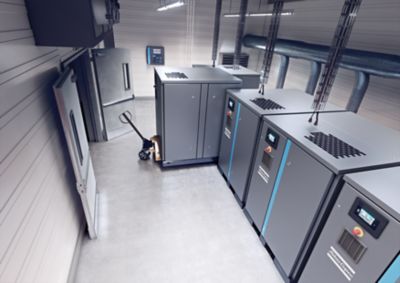The Hidden Value of Compressed Air Heat Recovery
Social responsibility is forcing manufacturers to find new ways of reducing their carbon emissions and energy consumption. Obvious steps like the use of low-energy light bulbs and automated heating offer some immediate carbon savings. However, even once these steps are taken, there remains a pressure to reduce further.
Aside from the negative impact of CO2 production on the environment, there is also the financial burden of energy usage. For this reason, manufacturing companies are actively exploring ways to lower their carbon footprint and enhance energy efficiency.
One area that offers manufacturers a significant opportunity to reduce CO2 emissions is recovering the waste heat from air compressors. While this approach has gained some traction in Europe, the adoption of compressed air energy recovery has been slower in the UK. The perceived complexity of heat recovery systems has contributed to the slow uptake. Nevertheless, research shows that significant benefits can be gained. The experience of those already pursuing this strategy confirms this data.
How compressing air generates heat?
Compressing air generates heat. This is a natural consequence of forcing more air molecules into the same space. The problem is that the air must be cooled before it can be used. In many systems, the air is cooled between compression stages and then again at the end. Intercoolers remove heat between the first and second stage and after-coolers remove heat after the second stage.
How heat can be recovered in compressed air systems?
Coolers remove heat from compressed air using air, water or oil. They work on a system of heat exchange. The air transfers heat to the cooling medium in a cooler designed for the compressor flow rate and energy transfer requirements. There are different types of cooling systems used in air compressors. Each one has advantages and disadvantages, and some can recover up to 94% of the supply energy to the air compressor.
Levels of heat recovery
Case studies of compressed air heat recovery
The untapped potential of heat recovery
These case studies demonstrate both the financial and environmental and financial opportunities of investing in compressed air heat recovery, yet most industrial companies in the UK are still yet to embrace and realise the benefits of the technology. Indeed, it is estimated that 90% of all industrial air compressors used in the UK could be equipped with heat recovery systems. And, as stated above, 70-94 % of the supply energy to an air compressor can be recovered.
To illustrate the vast untapped potential of compressed air heat recovery, it is calculated that the technology could save 1.99% of the total industrial electricity consumption in the UK. If that statistic isn’t compelling enough, it is the equivalent of removing the emissions from 913,000 diesel/petrol cars per year, or recovering the energy required to power 1.544 million households’ electricity consumption per year. Now, if that isn’t a compelling case for compressed air heat recovery, it’s difficult to say what is.
*Calculations are based on total industrial electricity consumption in the UK, and an average of 10% of industrial electricity consumption being used by compressors.
*Approximately 70% of energy is recoverable from oil-injected screw compressors, and up to 94% from oil-free water-cooled screw compressors.


